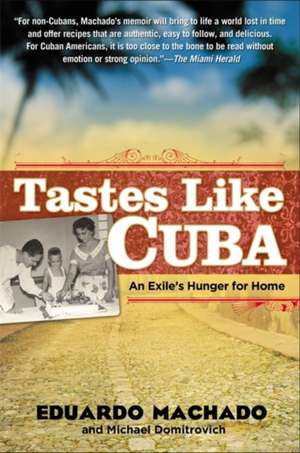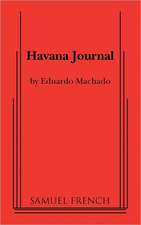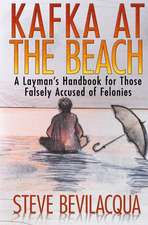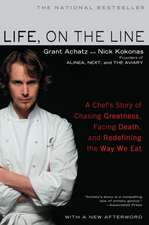Tastes Like Cuba: An Exile's Hunger for Home
Autor Eduardo Machado, Michael Domitrovichen Limba Engleză Paperback – 30 sep 2008 – vârsta de la 14 până la 13 ani
Born into a well-to-do family in Cuba in 1953, Eduardo Machado saw firsthand the effects of the rising Castro regime. When he and his brother were sent to the United States on one of the Peter Pan flights of 1961, they did not know if they would ever see their parents or their home again. From his experience living in exile in Los Angeles to becoming an actor, director, playwright and professor in New York, Machado explores what it means to say good-bye to the only home one’s ever known, and what it means to be a Latino in America today. Filled with delicious recipes and powerful tales of family, loss, and self discovery, Tastes Like Cuba delivers the story of Eduardo’s rich and delectable life—reminding us that no matter where we go, there is no place that feels (and tastes) better than home.
Preț: 135.25 lei
Nou
Puncte Express: 203
Preț estimativ în valută:
25.89€ • 28.13$ • 21.76£
25.89€ • 28.13$ • 21.76£
Carte disponibilă
Livrare economică 31 martie-14 aprilie
Preluare comenzi: 021 569.72.76
Specificații
ISBN-13: 9781592404056
ISBN-10: 1592404057
Pagini: 357
Dimensiuni: 135 x 203 x 19 mm
Greutate: 0.3 kg
Editura: GOTHAM BOOKS
ISBN-10: 1592404057
Pagini: 357
Dimensiuni: 135 x 203 x 19 mm
Greutate: 0.3 kg
Editura: GOTHAM BOOKS
Extras
One
Cojimar, 1958
I awoke to the smell of boiling milk. Not 1% or 2% or soy milk or rice milk. This milk had never touched a cardboard box. It had been freshly drawn, hours before, delivered at dawn from my grandmother's small farm just outside town. Every morning in our house was scented with the aroma of raw milk boiling with a little bit of salt.
If it were in my apartment now it would be contraband, a smuggled delicacy, but then, the foamy, silky, still-warm sweetness was a familiar part of every day. Once boiled, the cream would be ladled out and pressed into butter by our cook, Conchita, but at this early hour there was another priority. My grandmother Concepcion, along with Conchita, would be responsible for bringing life to a houseful of people, preparing the cafe con leche for at least fourteen.
It was the summer of 1958, and the Revolution was raging on. There was fighting in the Sierra Maestra and the surrounding provinces, far enough from our home for us to feel safe. But every night when Concepcion sat in the back of the house listening to the pirate radio frequency that Fidel Castro broadcast from, our sense of urgency and danger grew. There was an occasional bomb in Havana, and when I went into the city to go shopping with my mother, I would scan the storefronts and alleyways, making note of suspicious characters who could be the next martyrs for our cause. I sometimes feared that my father would go to work one morning and never return.
A quiet tension resulted. We were protected by the house, and we felt safe in our own little world. Still, I knew something was going on, but only because I listened. To the deliverymen who brought bright yellow bananas and pineapples. To the baker from town with his fresh bread and pastries. To the fishermen selling their early catches. And most of all to my grandmother Concepcion, whom we called Cuca, sharing the highlights of last night's broadcast with Conchita as the milk bubbled away.
"He said last night that he would stop the gambling casinos. Would that be something?" Cuca would say.
"Get rid of all those mobsters. That's why there's so much violence," whispered Conchita.
Let's pray he gets here soon."
Cuca was always the first one up. She took pride in her cafè, preparing it how everyone liked it, but always starting with the strong dark base of freshly brewed Cuban coffee. With all the fuss over the machinery we use to make the so-called perfect brew today, I wonder why we don't just keep it simple. Cuca did without automatic drips, heatproof presses, or grin Åen brew options. Instead she relied on her minimalist, functional gadget, her teta, nothing but a piece of cloth stitched around a metal hoop with a wooden handle. She would fill the teta with a few spoonfuls of coffee, then pour recently boiled water over the top. The freshness of the coffee was important, so it was best when served immediately, but Cuca had to contend with fourteen people waking at different times. She'd brew large batches of coffee to make sure there was enough, and if it cooled even slightly she'd freshen it up by adding piping hot milk into each cup.
It was the milk boiling, the coffee brewing, and the quiet whispers that woke me up every morning. I would leave my room, go down the hall and into the kitchen to sit at an expansive counter with twelve stools. My grandmother poured my coffee, topped it off with boiled milk, and added one, two, three teaspoons of Cuban sugar. Somehow she knew I was coming before I ever arrived, and timed it so that as I took my first sip of cafè, she would pop a piece of perfectly crisp, browned toast out of the toaster. She'd smear it with rich golden butter, than hand it to me on a little plate.
Cafè con leche with buttered toast is a true delicacy. It is so simple, yet provides so much joy. Cuban bread has a thin crust, and thought may resemble a baguette, it gives sooner to an airy inside. Its melting richness owes to its key ingredient: lard, which it is most often made with. When you dunk the toast, the bread takes on a spongy texture, accentuating the nuttiness of fine coffee. The milk is warming, soothing, and nutritive, the coffee gently invigorating. To feel truly decadent one needs to admire the droplets of shiny butter swimming on the surface of the cup.
I was only five years old, but I knew one thing for sure. All I had to do was dunk the bread into the cup. Chew, sip, and heaven in the morning was possible.
The rest of the house would take longer to wake up. One by one or in pairs, the kitchen would be visited by my aunts and uncles. They would emerge from their rooms, fully made up, perfumed and pomaded in silk pajamas or negligees with lace cutouts. My father and his brothers Fernando and Oscar would most often collect their cafè and return to their rooms with cups for their wives. While our parents woke up in private, my cousins Lupe, Maria Elena, Fenandito, and Oscarito sat with me in the kitchen. Sometimes our single uncles Pipo and Benito would join us, or they would meet up with their sister Maria in the French-style rose garden adjoining the house.
You might think living with so many people would be chaotic, but if anything it was more like a perfectly planned and executed garden party, every morning, day after day. Sometimes I wonder why I tend toward living casually as an adult: I am barefoot whenever possible and refuse to touch an iron. I used to think it was a California thing—absorbed from twenty years of West Coast living—but more and more it seems a form of rebellion against a childhood where formality was always present, even at eight in the morning.
Still, beneath all the composure lay a tumult of conflict. Four different families living under one roof makes for a dangerous cocktail of competition and emotion. My father's sisters-in-law, who had been poor growing up in Guanabacoa, now had to vie for Cuca and Fernando's attention and money. They did their best to remain poised while scraping and scrambling for a compliment or a handout from the heads of the family, but it's not easy to hide desperation. My mother always felt superior, proud that neither she nor her son would have to beg for anything from her husband's parents. We had her parents, Oscar and Manuela, and they were always just a few steps away.
Before breakfast was over, Cuca would already be peeling root vegetables. By eleven A.M. at the latest, you could hear the sound of her knife chopping up the malanga, yuca and pumpkin for a staple of her kitchen, Newspaper Soup. The preparation of this tropical vegetable potage ushered in a different set of sounds, another group of familiar smells that could only mean one thing: lunch.
In my family, you didn't rush in to or out of anything having to do with food. Especially when it was lunch. Our whole family was on a different schedule, and the midday meal was our opportunity to be together. We'd have our leisurely morning, then as the men went off to work and we children went to school, the women went and did what they did—start preparing lunch. Lunch was really a three-hour break during the hottest part of the day. If we had been served a plate of rice and nothing else, I'm sure we would have taken just as much time to enjoy the break. But the thing I liked the most about lunch was that it was a meal when the most choices were available. What to eat depended first on where it could be eaten. Would I dine at the table of my puritanical grandmother or down the hall with her wild-eyed husband? Perhaps I'd take the less dramatic option and cross the street to the home of my other grandparents.
In my grandparents' house on my father's side there was a civil war of culinary ideology. The house was large enough to have two dining rooms, and each one was presided over by a different grandparent. Though they had been married for thirty years, Cuca's and Fernando's personal tastes could not have been further apart. The distance between their separate dining rooms enforced this idea, as did the fact that neither one dined in the other's space.
The middle dining room was Cuca's domain. To understand her particular taste, you must understand something else about her. She was thin, even by today's standards. And then, in 1958, in comparison to the other voluptuous women of Havana, she was like Twiggy. On a diet. And what about this Newspaper Soup? The story goes that it was from a recipe printed in the newspaper in the 1930s. When Cuca ripped the recipe from the paper, she missed the topmost portion that contained the actual name of the soup. So, adapting accordingly, the soup was christened.
And what a soup it was. I am sure that if a health guru tasted it today it would quickly be declared the newest fountain of youth. Rich in fiber and nutrients, Newspaper Soup walked the line between the delectable and the medicinal, making me dread it and crave it all at once. The flavors of the roots were both blended and distinct. The waxy starch of malanga, the nutty thickness of yuca, and the sweetness and color of pumpkin all combined to produce a complex heartiness, not unlike the best chicken stocks or veal broths. What was so great about the soup, though, was its adaptability.
There was always a pot bubbling away, which meant that an array of garnishes to accompany were not far off. Chopped ham, hard-boiled eggs, and crispy croutons added accents of texture and overtones of saltiness that further emphasized the strength and depth of the thick soup.
Beyond this nutritive starter, the other familiar presence at Cuca's lunch table was, of course, beans and rice. But Cuca's beans were different. I guess she had a thing about pureeing because her bean dish was more the texture of Newspaper Soup, thick enough to coat a spoon, without a bean in sight. The dish was hearty but not heavy, with a mild smokiness and sweetness. Cuca's smooth puree, served over bowls of flaky white rice, managed to elevate a staple to a culinary treasure.
The rest of the menu wouldn't be health conscious by today's standards. Most of it was fried. Bistec empanizado, or breaded steaks, was a favorite of mine. Like the Cuban version of Veal Milanese, it is made from the top round or palomillo portion of the cow. The steaks are portioned and pounded thin, dipped in egg and crushed Cuban crackers, or galletas, the fried in lard or oil. Cuca also liked to use this method when preparing fish.
No matter the protein Cuca made, it was always served with rice, pureed beans, Newspaper Soup, and sweet plantains. And that was it. Every day. The same thing. If we were very lucky, we might get a little sliced avocado with lime or (heaven be praised) homemade croquetas with chicken or ham.
How did Cuca stay so thin? For her, everything was portioned out in relation to the size of the dish. While the rest of us got big plates with hearty servings, Cuca herself dined only on demitasse plates. One ounce of steak, one piece of banana, a tablespoon of rice, and a teaspoon of beans. Every day, with lots of coffee and boiled milk. Looking back, I can see that maybe she was just ahead of her time. How many ladies who lunch finish everything on their plates? Cuca simply took what she needed, although I'm sure she could have done with a little more. Still, she practiced this self-restraint every time, even though she wasn't all willpower. In fact, Cuca had a dark little secret, one that is shared by well-heeled women the world over: She was saving herself. For dessert.
It is the sweetness that I remember when I dream of Cuca's table. More than the Newspaper Soup. More than the Bistec Empanizado. Meringues float before my eyes, baked gently in the oven until dry and crisp. They were brown, which I marveled at, not white like the ones at the bakery in front of the convent where my mother went to school. Those were sacred meringues, made by nuns, pure and clean. Cuca's meringues had something of the earth in them, but the simple sweetness was still the same. Cuban sugar and fluffy egg whites, holding the shape she gave them, only to dissolve on my tongue and become more a part of me than I ever thought possible. Truly, that is the sweetness I remember.
Newspaper Soup
This is my grandmother Cuca's infamous recipe. I remember eating it nearly every day in Cuba, although my mother claims I refused it on many occasions. There is an interesting chemistry at work here: The water from the pumpkin thins the soup out while the starch from the malanga thickens it up in the second cooking. This vegetarian soup is certainly healthy, but it's also quite tasty. The sunny color and hearty warmth make it perfect for lunch on a chilly day, but this comforting cure-all works its magic any time of year.
** Calabasa pumpkin is round, greenish-skinned tropical pumpkin. Its orange flesh is sweeter and faster cooking than a traditional pumpkin. They are very big, so they are usually sold in smaller pieces. Should you not find calabasas, butternut squash makes a fine substitute.
Cojimar, 1958
I awoke to the smell of boiling milk. Not 1% or 2% or soy milk or rice milk. This milk had never touched a cardboard box. It had been freshly drawn, hours before, delivered at dawn from my grandmother's small farm just outside town. Every morning in our house was scented with the aroma of raw milk boiling with a little bit of salt.
If it were in my apartment now it would be contraband, a smuggled delicacy, but then, the foamy, silky, still-warm sweetness was a familiar part of every day. Once boiled, the cream would be ladled out and pressed into butter by our cook, Conchita, but at this early hour there was another priority. My grandmother Concepcion, along with Conchita, would be responsible for bringing life to a houseful of people, preparing the cafe con leche for at least fourteen.
It was the summer of 1958, and the Revolution was raging on. There was fighting in the Sierra Maestra and the surrounding provinces, far enough from our home for us to feel safe. But every night when Concepcion sat in the back of the house listening to the pirate radio frequency that Fidel Castro broadcast from, our sense of urgency and danger grew. There was an occasional bomb in Havana, and when I went into the city to go shopping with my mother, I would scan the storefronts and alleyways, making note of suspicious characters who could be the next martyrs for our cause. I sometimes feared that my father would go to work one morning and never return.
A quiet tension resulted. We were protected by the house, and we felt safe in our own little world. Still, I knew something was going on, but only because I listened. To the deliverymen who brought bright yellow bananas and pineapples. To the baker from town with his fresh bread and pastries. To the fishermen selling their early catches. And most of all to my grandmother Concepcion, whom we called Cuca, sharing the highlights of last night's broadcast with Conchita as the milk bubbled away.
"He said last night that he would stop the gambling casinos. Would that be something?" Cuca would say.
"Get rid of all those mobsters. That's why there's so much violence," whispered Conchita.
Let's pray he gets here soon."
Cuca was always the first one up. She took pride in her cafè, preparing it how everyone liked it, but always starting with the strong dark base of freshly brewed Cuban coffee. With all the fuss over the machinery we use to make the so-called perfect brew today, I wonder why we don't just keep it simple. Cuca did without automatic drips, heatproof presses, or grin Åen brew options. Instead she relied on her minimalist, functional gadget, her teta, nothing but a piece of cloth stitched around a metal hoop with a wooden handle. She would fill the teta with a few spoonfuls of coffee, then pour recently boiled water over the top. The freshness of the coffee was important, so it was best when served immediately, but Cuca had to contend with fourteen people waking at different times. She'd brew large batches of coffee to make sure there was enough, and if it cooled even slightly she'd freshen it up by adding piping hot milk into each cup.
It was the milk boiling, the coffee brewing, and the quiet whispers that woke me up every morning. I would leave my room, go down the hall and into the kitchen to sit at an expansive counter with twelve stools. My grandmother poured my coffee, topped it off with boiled milk, and added one, two, three teaspoons of Cuban sugar. Somehow she knew I was coming before I ever arrived, and timed it so that as I took my first sip of cafè, she would pop a piece of perfectly crisp, browned toast out of the toaster. She'd smear it with rich golden butter, than hand it to me on a little plate.
Cafè con leche with buttered toast is a true delicacy. It is so simple, yet provides so much joy. Cuban bread has a thin crust, and thought may resemble a baguette, it gives sooner to an airy inside. Its melting richness owes to its key ingredient: lard, which it is most often made with. When you dunk the toast, the bread takes on a spongy texture, accentuating the nuttiness of fine coffee. The milk is warming, soothing, and nutritive, the coffee gently invigorating. To feel truly decadent one needs to admire the droplets of shiny butter swimming on the surface of the cup.
I was only five years old, but I knew one thing for sure. All I had to do was dunk the bread into the cup. Chew, sip, and heaven in the morning was possible.
The rest of the house would take longer to wake up. One by one or in pairs, the kitchen would be visited by my aunts and uncles. They would emerge from their rooms, fully made up, perfumed and pomaded in silk pajamas or negligees with lace cutouts. My father and his brothers Fernando and Oscar would most often collect their cafè and return to their rooms with cups for their wives. While our parents woke up in private, my cousins Lupe, Maria Elena, Fenandito, and Oscarito sat with me in the kitchen. Sometimes our single uncles Pipo and Benito would join us, or they would meet up with their sister Maria in the French-style rose garden adjoining the house.
You might think living with so many people would be chaotic, but if anything it was more like a perfectly planned and executed garden party, every morning, day after day. Sometimes I wonder why I tend toward living casually as an adult: I am barefoot whenever possible and refuse to touch an iron. I used to think it was a California thing—absorbed from twenty years of West Coast living—but more and more it seems a form of rebellion against a childhood where formality was always present, even at eight in the morning.
Still, beneath all the composure lay a tumult of conflict. Four different families living under one roof makes for a dangerous cocktail of competition and emotion. My father's sisters-in-law, who had been poor growing up in Guanabacoa, now had to vie for Cuca and Fernando's attention and money. They did their best to remain poised while scraping and scrambling for a compliment or a handout from the heads of the family, but it's not easy to hide desperation. My mother always felt superior, proud that neither she nor her son would have to beg for anything from her husband's parents. We had her parents, Oscar and Manuela, and they were always just a few steps away.
Before breakfast was over, Cuca would already be peeling root vegetables. By eleven A.M. at the latest, you could hear the sound of her knife chopping up the malanga, yuca and pumpkin for a staple of her kitchen, Newspaper Soup. The preparation of this tropical vegetable potage ushered in a different set of sounds, another group of familiar smells that could only mean one thing: lunch.
In my family, you didn't rush in to or out of anything having to do with food. Especially when it was lunch. Our whole family was on a different schedule, and the midday meal was our opportunity to be together. We'd have our leisurely morning, then as the men went off to work and we children went to school, the women went and did what they did—start preparing lunch. Lunch was really a three-hour break during the hottest part of the day. If we had been served a plate of rice and nothing else, I'm sure we would have taken just as much time to enjoy the break. But the thing I liked the most about lunch was that it was a meal when the most choices were available. What to eat depended first on where it could be eaten. Would I dine at the table of my puritanical grandmother or down the hall with her wild-eyed husband? Perhaps I'd take the less dramatic option and cross the street to the home of my other grandparents.
In my grandparents' house on my father's side there was a civil war of culinary ideology. The house was large enough to have two dining rooms, and each one was presided over by a different grandparent. Though they had been married for thirty years, Cuca's and Fernando's personal tastes could not have been further apart. The distance between their separate dining rooms enforced this idea, as did the fact that neither one dined in the other's space.
The middle dining room was Cuca's domain. To understand her particular taste, you must understand something else about her. She was thin, even by today's standards. And then, in 1958, in comparison to the other voluptuous women of Havana, she was like Twiggy. On a diet. And what about this Newspaper Soup? The story goes that it was from a recipe printed in the newspaper in the 1930s. When Cuca ripped the recipe from the paper, she missed the topmost portion that contained the actual name of the soup. So, adapting accordingly, the soup was christened.
And what a soup it was. I am sure that if a health guru tasted it today it would quickly be declared the newest fountain of youth. Rich in fiber and nutrients, Newspaper Soup walked the line between the delectable and the medicinal, making me dread it and crave it all at once. The flavors of the roots were both blended and distinct. The waxy starch of malanga, the nutty thickness of yuca, and the sweetness and color of pumpkin all combined to produce a complex heartiness, not unlike the best chicken stocks or veal broths. What was so great about the soup, though, was its adaptability.
There was always a pot bubbling away, which meant that an array of garnishes to accompany were not far off. Chopped ham, hard-boiled eggs, and crispy croutons added accents of texture and overtones of saltiness that further emphasized the strength and depth of the thick soup.
Beyond this nutritive starter, the other familiar presence at Cuca's lunch table was, of course, beans and rice. But Cuca's beans were different. I guess she had a thing about pureeing because her bean dish was more the texture of Newspaper Soup, thick enough to coat a spoon, without a bean in sight. The dish was hearty but not heavy, with a mild smokiness and sweetness. Cuca's smooth puree, served over bowls of flaky white rice, managed to elevate a staple to a culinary treasure.
The rest of the menu wouldn't be health conscious by today's standards. Most of it was fried. Bistec empanizado, or breaded steaks, was a favorite of mine. Like the Cuban version of Veal Milanese, it is made from the top round or palomillo portion of the cow. The steaks are portioned and pounded thin, dipped in egg and crushed Cuban crackers, or galletas, the fried in lard or oil. Cuca also liked to use this method when preparing fish.
No matter the protein Cuca made, it was always served with rice, pureed beans, Newspaper Soup, and sweet plantains. And that was it. Every day. The same thing. If we were very lucky, we might get a little sliced avocado with lime or (heaven be praised) homemade croquetas with chicken or ham.
How did Cuca stay so thin? For her, everything was portioned out in relation to the size of the dish. While the rest of us got big plates with hearty servings, Cuca herself dined only on demitasse plates. One ounce of steak, one piece of banana, a tablespoon of rice, and a teaspoon of beans. Every day, with lots of coffee and boiled milk. Looking back, I can see that maybe she was just ahead of her time. How many ladies who lunch finish everything on their plates? Cuca simply took what she needed, although I'm sure she could have done with a little more. Still, she practiced this self-restraint every time, even though she wasn't all willpower. In fact, Cuca had a dark little secret, one that is shared by well-heeled women the world over: She was saving herself. For dessert.
It is the sweetness that I remember when I dream of Cuca's table. More than the Newspaper Soup. More than the Bistec Empanizado. Meringues float before my eyes, baked gently in the oven until dry and crisp. They were brown, which I marveled at, not white like the ones at the bakery in front of the convent where my mother went to school. Those were sacred meringues, made by nuns, pure and clean. Cuca's meringues had something of the earth in them, but the simple sweetness was still the same. Cuban sugar and fluffy egg whites, holding the shape she gave them, only to dissolve on my tongue and become more a part of me than I ever thought possible. Truly, that is the sweetness I remember.
Newspaper Soup
This is my grandmother Cuca's infamous recipe. I remember eating it nearly every day in Cuba, although my mother claims I refused it on many occasions. There is an interesting chemistry at work here: The water from the pumpkin thins the soup out while the starch from the malanga thickens it up in the second cooking. This vegetarian soup is certainly healthy, but it's also quite tasty. The sunny color and hearty warmth make it perfect for lunch on a chilly day, but this comforting cure-all works its magic any time of year.
- 3 celery stalks
- 4 carrots, peeled
- 1 Spanish onion, peeled
- 1 green pepper, stem and seeds removed
- 2 pounds malanga*
- 3 to 4 pounds calabasa pumpkin**
- 2/3 cup olive oil
- 4 garlic cloves, peeled and smashed
- 1/2cup Goya tomato sauce (from one 8-ounce can)
- 1/4 gram of saffron (about 1 big pinch)
- 8 cups water
- Up to 2 tablespoons salt
- Up to 1/2 teaspoon ground black pepper
** Calabasa pumpkin is round, greenish-skinned tropical pumpkin. Its orange flesh is sweeter and faster cooking than a traditional pumpkin. They are very big, so they are usually sold in smaller pieces. Should you not find calabasas, butternut squash makes a fine substitute.
- Prepare the vegetables: Cut the celery stalks into 1-inch pieces. Cut the carrots into 1-inch chunks. Slice the onion in half, then cut each half into chunks about 1-inch square. Slice the green pepper in half, then cut each half into chunks about 1-inch square. Peel each malanga with a vegetable peeler, then slice in half. Cut crosswise into chunks about 1-inch thick. Peel the tough skin from the calabasa pumpkin by slicing close to the flesh with a sharp knife. Remove any seeds with a spoon and cut the pumpkin into chunks about 1-inch square.
- In an 8 quart soup pot, heat the olive oil over medium-high heat until hot but not smoking. Sautè the celery, carrots, onion, and green pepper, stirring occasionally until softened and lightly browned, 10 minutes.
- Add the malanga, pumpkin, garlic, tomato sauce, saffron, and water. Season with 1 tablespoon of the salt. Bring to a boil. Cover and reduce the heat to medium. Cook at a gentle boil until soft enough to puree, about 1 hour. Turn off the heat and cool slightly, 15 minutes.
- Puree the soup using an immersion blender. If you don't have an immersion blender, puree in batches using a standing blender. Note: Make sure you don't overfill the blender, and that the lid is slightly ajar so any steam can escape, otherwise you'll end up with a hot mess all over the place.
- Return the puree to the stove. Bring to boil over medium heat and simmer, covered, for 30 minutes, stirring occasionally. Taste and adjust the seasoning using no more than 1 tablespoon salt and 1/2 teaspoon black pepper. The salt needed will depend on how starchy the vegetables are, as well as personal preference. Serve with bread and butter, or a garnish of croutons, chopped ham, and sliced hard-boiled eggs.
Notă biografică
Eduardo Machado























